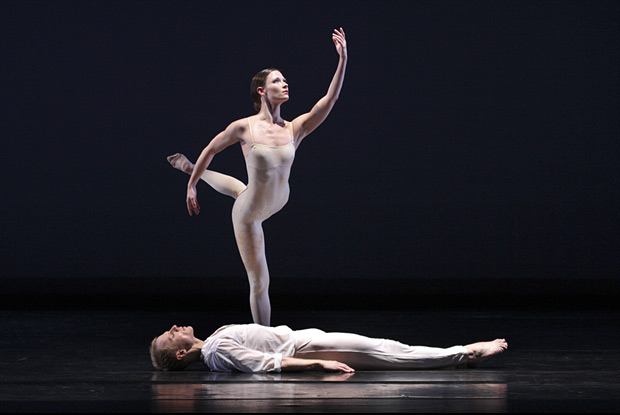
© Paul B. Goode. (Click image for larger version)
Paul Taylor Dance Company
Cascade, To Make Crops Grow, Beloved Renegade
New York, David H. Koch Theater
13 March 2013
www.ptdc.org
davidhkochtheater.com
Paul Taylor, Storyteller
In recent years, Paul Taylor’s tendency has been to create two (or sometimes three) new works per year. The past two seasons, these have included a meditation on coupling counterbalanced by a kind of morality play. It’s an interesting pattern. Last year we saw The Uncommitted and House of Joy (plus one of his zany pieces, Gossamer Gallants). In the first, a series of figures struggled, in vain, to connect; the dance ended with Michael Trusnovec and Laura Halzack – two of Taylor’s most limpid, noble dancers – engaged in an encounter steeped in misunderstanding and regret. As the curtain fell, the two walked away from each other, alone and unhappy. In contrast, House of Joy was a mime-play with almost no dance, depicting a scene at a brothel. In its abrupt dénouement, a rather naive young man (Michael Novak) was beaten up and then consoled lovingly by one of the pimps. The two men left arm in arm, perhaps to find a different kind of bliss. Innocence – the possibility of love – won out.
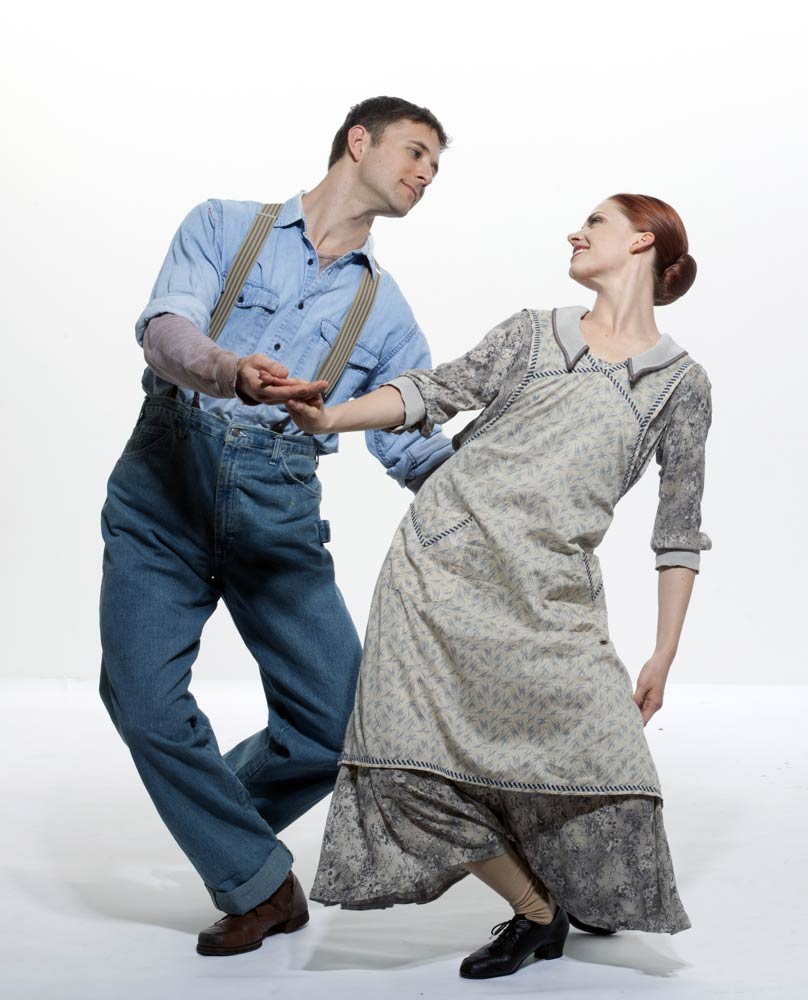
© Tom Caravaglia. (Click image for larger version)
This year’s premières are like a negative image of what came before. Perpetual Dawn, which opened last week, is a happy couples dance, set to generically upbeat music by the German baroque composer, Johann David Heinichen. Lovers frolic, embrace, chase after each another in a bucolic setting. Even the lone single girl (Michelle Fleet) eventually finds a man. Then there is To Make Crops Grow, which I saw for the first time last night. It turns out to be a rather creepy fable about society’s willingness to sacrifice one of its own to satisfy some sort of higher law – order, convention? Again, there is very little dancing. What is Taylor trying to tell us with these moral tales? They are certainly not crowd pleasers; the audience, in both cases, has responded with tepid applause. Despite their “surprise” endings, they are formulaic, and virtually dance-free. At the same time, there is something intriguing about them. They reveal a strange corner of Taylor’s imagination, one that has consistently surfaced throughout his career: his fascination with human weakness and intolerance. Those who are “different” are cast out, pummeled.
In House of Joy, the victim was an un-cynical young man who came looking for more than a quick lay. In the end, he found a friend. In To Make Crops Grow it’s the sexy vamp, played vividly by Parisa Khobdeh. She is not so lucky. The women gossip about her; in response, she flaunts her curves, perhaps as a form of self-defense. Her husband – Michael Apuzzo, dressed in a dapper white suit with padding around the middle – ignores her completely. A look at the program tells you a lot about Taylor’s attitudes toward these people: Khobdeh is the “young wife,” Apuzzo the “elderly husband;” Heather McGinley and James Samson are the “needy couple.” Taylor doesn’t sympathize, at least not much. Last year he told me that he was beginning to work on a dance inspired by a short story set in the thirties or forties, and this seems to be it. Though it echoes aspects of the Rite of Spring, it seems to scan the events in Shirley Jackson’s “The Lottery” more closely. Like Jackson’s discreetly acidic tale, published in the New Yorker magazine in 1948, it ends with a stoning, and leaves a bitter taste. (Michael Haneke’s White Ribbon tells a similar tale about a pretty town, inhabited by awful people.) Khobdeh’s desperate attempts to flee, hair flying, legs flailing, are harrowing. This is not the first time Taylor has entered the darker corners of civilized brutality (think Cloven Kingdom and Big Bertha, or Speaking in Tongues). But To Make Crops Grow does not have the same power, perhaps because, like House of Joy, it’s just too bare-boned, too pat. (On the other hand, the music, excerpts of Ferde Grofé’s Grand Canyon Suite, suits the story quite nicely.) It is neither shocking enough nor original enough to leave much of an aftertaste.
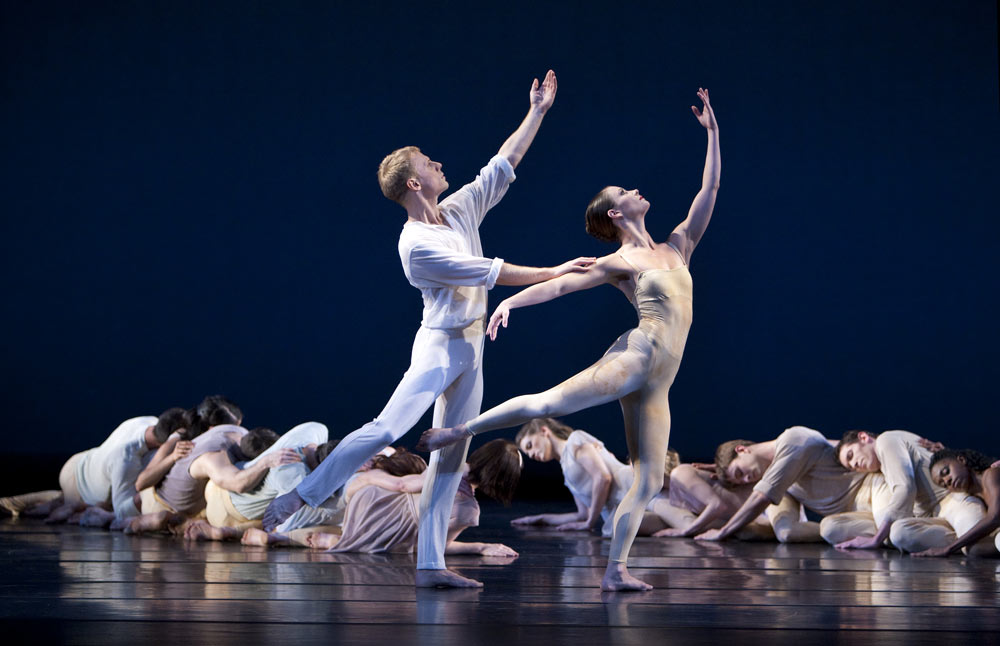
© Paul B. Goode. (Click image for larger version)
The same cannot be said about Beloved Renegade, from 2009, also performed last night. I’d venture to say that this is one of Taylor’s great works, heartfelt, profound, complex and deeply musical. For an avowed atheist, he has a strong sense of ritual and religious iconography. The pietà is a repeated image here, as is the outstretched palm of the Byzantine saint. In the “Domine Deus” (to which Taylor has given the Whitmanesque title “I bend to the dying lad, his eyes open”), Amy Young is a kind of penitent, repeatedly striking her thighs with her fists. Behind her, wounded men stumble out of the wings, visibly suffering, dying. Michael Trusnovec, the dance’s central figure, tends to them with great tenderness, even love: stroking their cheeks, cradling them, even kissing one on the lips. He can’t save them, but he gives them love and comfort. Beloved Renegade is a kind of self-portrait of the artist, refracted through the figure of Walt Whitman. The man in white watches scenes from the seasons of his life, played like flash-backs, out of order: in love, at play, in moments of doubt. Sometimes he takes part in the action; often he watches from afar. Every chapter is a farewell, a foreshadowing of the end. A seraphic figure (Laura Halzack) moves slowly around and toward him, gently leading him toward his inevitable exit. (Halzack’s steady, slow, fluid movements and placid face are perfectly suited to this role.) The sensual caresses of two young lovers early on – hand on leg, groin, heart – are echoed by Halzack’s hand, lightly brushing Trusnovec’s body; the hot touch of youth is replaced by the cool, comforting touch of angels. More than usual, the steps and underlying themes are in perfect accord with the music, and even the religious text. Both the music and the dance are elevated as a result. The work lingers in the heart.
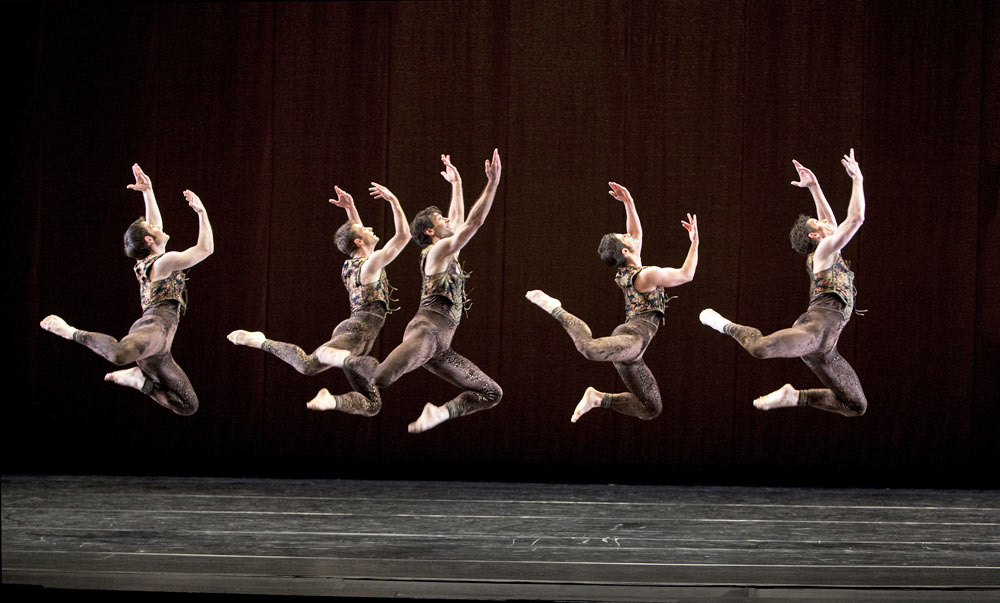
Cascade.
© Paul B. Goode. (Click image for larger version)
Renegade certainly suffers from being accompanied by a truly pallid recording. It is a recurring problem with Taylor, more noticeable since the company moved to Lincoln Center. The wide, deep pit lies empty and dark. The recordings used by the company do not do justice to the music – or is it the theatre’s sound system? Is there no chance that one day money might be raised for the purpose of providing live accompaniment? And if recordings are unavoidable, are these really the best we can hope for? The recording used by the company for Cascade, of various movements from Bach concerti, is particularly mechanical and dry. It sounds as if it had been recorded under the sea. One would think there must be better versions available. Then again, Cascade isn’t really about the music. It’s what I think of as boilerplate Taylor: well-constructed, pleasing, full of recognizable Taylor gestures: the leaping run, the tilted spins, the circles, the agile grouping and regrouping of dancers onstage. In the second movement, two couples shadow each other, the man from one echoing the movements of the woman from the other. The couples touch; the men carry and cradle the women in low lifts. Meanwhile, Bach’s concerti play in the background, not quite ignored, but not really part of the action either. Until suddenly it all snaps into focus. At the heart of Cascade lies a solo, danced here by Amy Young; the music is the Largo from Bach’s Fifth Concerto, a piece altogether too familiar for its own good. But it doesn’t matter because the steps capture the music’s quiet, meditative quality perfectly; Young holds out her palm on a ringing note, and both the image of her hand and the sound of the note resonate in our mind. Like the music, she is saying something simple and profound about the human condition. It’s what Taylor does best.












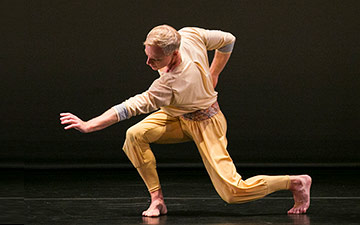

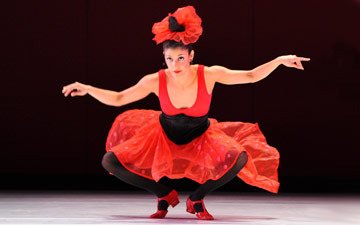
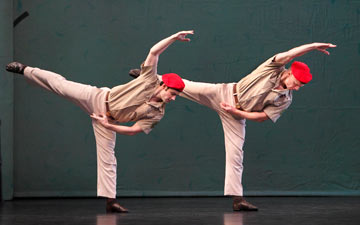
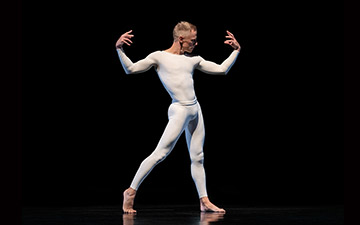
You must be logged in to post a comment.